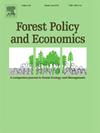森林保护是增加森林碳封存的社会最优策略吗?
IF 3.8
2区 农林科学
Q1 ECONOMICS
引用次数: 0
摘要
以往的研究表明,当碳价足够高时,最优的循环周期是无限长的,这表明森林保护可以作为减缓全球变暖的最优策略。本文考察了采伐木制品替代效应和自然扰动风险对无限长轮作周期最优性的影响。我们的分析表明,当HWP的替代效应显著时,无论碳价格多高,最优轮换都是有限的。相反,当替代效应最小时,存在一个阈值碳价格,超过该阈值,最优轮换周期将变得无限。此外,我们证明,自然干扰的风险可以增加或减少森林保护仍然是减缓气候变化的最佳选择的可能性。数值算例表明,即使对HWP的替代效应进行保守假设,最优轮作仍然是有限的,而森林破坏的风险进一步降低了最优轮作。本文章由计算机程序翻译,如有差异,请以英文原文为准。
Is forest conservation a socially optimal strategy for increasing forest carbon sequestration?
Previous studies show that the optimal rotation period would be infinitely long when carbon price is sufficiently high, indicating that forest preservation could serve as an optimal strategy for mitigating global warming. This paper examines the impact of the substitution effect of harvested wood products (HWP) and the risk of natural disturbances on the optimality of infinitely long rotation period. Our analysis shows that when the substitution effects of HWP are significant, the optimal rotation remains finite regardless of how high the carbon price is. Conversely, when the substitution effects are minimal, there exists a threshold carbon price beyond which the optimal rotation period becomes infinite. Furthermore, we demonstrate that the risk of natural disturbances can either increase or decrease the likelihood that forest preservation remains the optimal choice for climate change mitigation. A numerical example illustrates that even with conservative assumptions about the substitution effect of HWP, the optimal rotation remains finite, and the risk of forest damage further reduces the optimal rotation.
求助全文
通过发布文献求助,成功后即可免费获取论文全文。
去求助
来源期刊

Forest Policy and Economics
农林科学-林学
CiteScore
9.00
自引率
7.50%
发文量
148
审稿时长
21.9 weeks
期刊介绍:
Forest Policy and Economics is a leading scientific journal that publishes peer-reviewed policy and economics research relating to forests, forested landscapes, forest-related industries, and other forest-relevant land uses. It also welcomes contributions from other social sciences and humanities perspectives that make clear theoretical, conceptual and methodological contributions to the existing state-of-the-art literature on forests and related land use systems. These disciplines include, but are not limited to, sociology, anthropology, human geography, history, jurisprudence, planning, development studies, and psychology research on forests. Forest Policy and Economics is global in scope and publishes multiple article types of high scientific standard. Acceptance for publication is subject to a double-blind peer-review process.
 求助内容:
求助内容: 应助结果提醒方式:
应助结果提醒方式:


